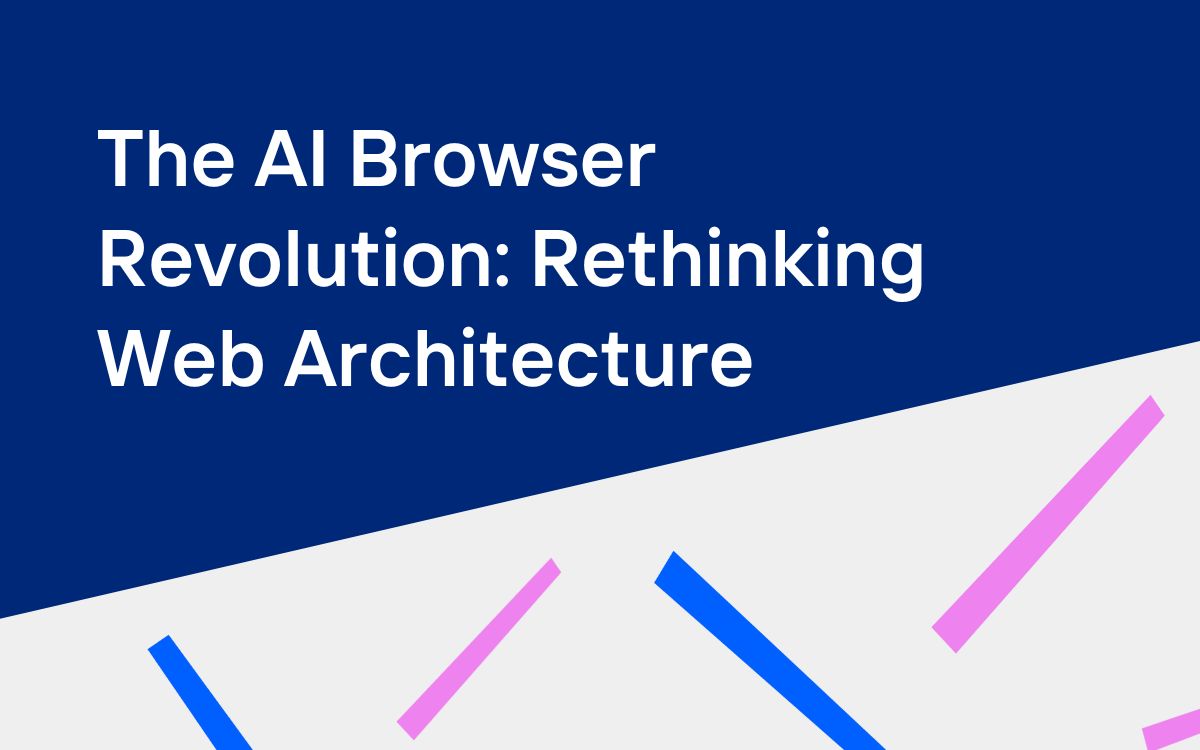TL;DR – The AI Browser Revolution
The web is undergoing a fundamental transformation as AI-powered browsers from Perplexity, OpenAI, and others enable unprecedented automation capabilities. While we’re excited about the productivity and accessibility benefits of agentic browsing, security professionals must remember a key lesson from the past: bad actors don’t follow rules — they weaponize legitimate technologies.
The core challenge:
- Agentic browsing: Legitimate AI-powered automation for research, accessibility, productivity
- Agentic botting: Same AI capabilities used to evade detection and exploit systems
- Gray area problem: Distinguishing between human and bot behavior becomes nearly impossible
Our research breakthrough:
- Different AI models (Claude, OpenAI Agent, Gemini) leave distinct behavioral signatures
- Organizations can now attribute automation to specific AI providers
- Current detection systems fail against reasoning-based automation from both legitimate and malicious sources
The security industry must evolve to effectively manage this dual-use technology.
—————————————————————-
The way we interact with the web is changing. As browsers incorporate AI capabilities, we’re seeing the emergence of distinct phenomena that challenge traditional web architecture: agentic browsers and agentic browsing.
Agentic browsers, like Perplexity’s Comet and OpenAI’s upcoming browser alongside Opera Neon, represent a meaningful shift from passive content display to active assistance. These browsers understand user context, learn from behavior patterns, and help automate routine tasks. When your browser can intelligently cache content, understand natural language instructions, and manage complex workflows, it fundamentally changes the relationship between client and server.
Agentic browsing extends these capabilities into practical applications. Researchers use AI-powered tools to synthesize findings across multiple sources. Businesses automate complex workflows that previously required manual navigation. Accessibility tools leverage AI to make web content more inclusive, and they represent a new model of web interaction.
Recent research from Anthropic reveals that AI task completion capabilities are following predictable scaling laws, with time horizons doubling every 7 months. What begins as simple automation rapidly evolves into sophisticated reasoning systems capable of multi-session persistence and adaptive problem-solving.
This evolution raises important questions about web architecture. As browsers become more capable of local processing and intelligent caching, do all interactions need to flow through traditional web servers? Could some applications work more effectively through direct peer-to-peer communication or local computation? The client-server model that has served the web for decades may need to evolve for this new reality.
The Three-Tier Reality
However, these technological advances come with complex security implications. To understand the challenges ahead, we must distinguish between three fundamentally different approaches to AI-powered web interaction:
- Agentic browsers like Perplexity’s Comet, OpenAI’s forthcoming browser, Arc, and Opera Neon openly integrate AI features and market their automation capabilities. They want visibility and cooperation, representing legitimate productivity tools that organizations can manage through policy frameworks.
- Agentic browsing involves legitimate automation using AI for beneficial purposes — research, accessibility, and business processes. These applications serve genuine needs but may not declare their AI usage, creating gray areas for security policies.
- Agentic botting represents sophisticated actors using AI specifically to evade detection and exploit systems. This includes systematic security research, fraud operations, market manipulation, and industrial espionage conducted through reasoning-based automation that adapts to defensive measures.
The distinction between these categories becomes critical as capabilities advance. OWASP has officially recognized agentic AI threats as requiring distinct mitigation approaches from traditional LLM risks, while security vendors acknowledge that conventional detection methods prove inadequate against reasoning-based automation.
The Agentic Browsing Challenge
The emergence of AI-powered browsers fundamentally transforms web security by legitimizing sophisticated automation. When browsers like Perplexity’s Comet, OpenAI’s browser, Arc, and Opera Neon incorporate AI capabilities, they normalize exactly the kind of automated behavior that security systems were designed to detect and prevent.
This represents an acceleration of proven attack patterns. Bot developers have long exploited legitimate browsers through “stealthified” frameworks like Puppeteer and Playwright. Now, as AI capabilities become standard browser features, the line between legitimate automation and malicious exploitation disappears entirely.
Recent controlled testing demonstrates this threat’s immediacy. By providing an LLM with three automation frameworks (Playwright, Puppeteer Extra Stealth, and Patchright) and using only natural language prompts, sophisticated bot evasion becomes accessible to anyone capable of conversation. The LLM successfully analyzed framework documentation, developed comparative understanding of evasion capabilities, and iteratively defeated multiple protection systems, including slides, press-and-hold, and puzzle-based CAPTCHAs.
More significantly, this testing revealed that different LLM providers create distinguishable automation signatures. Traffic analysis shows distinct behavioral patterns for Claude, OpenAI Agent, Gemini, DeepSeek, and other models — each exhibiting unique timing, interaction sequences, and decision-making approaches when conducting identical tasks. This discovery enables a new form of attribution: organizations can now identify not just that agentic automation is occurring, but which AI model is generating it.
The security challenge is existential: when sophisticated automation becomes a standard browser feature, traditional detection methods collapse. Security systems must somehow distinguish beneficial AI-powered browsing from malicious exploitation while both use identical technical capabilities and behavioral patterns.
The key breakthrough driving this threat is what Anthropic researchers identify as self-correction capability. Unlike traditional bots that fail predictably, agentic systems can notice mistakes, adapt their approach, and route around defensive measures. This adaptive capability breaks static detection systems because agents learn from each defensive encounter.
The CAPTCHA Collapse Microcosm
The CAPTCHA’s decline perfectly illustrates AI’s acceleration of existing vulnerabilities. Bot operators have long defeated CAPTCHAs through two methods:
- Challenge Avoidance: Using expert browser fingerprinting and behavioral mimicry to qualify for CAPTCHA providers’ “trusted user” paths.
- Solving at Scale: Replacing expensive human solving farms with more accurate, cheaper AI solutions.
Modern agentic botting perfects both approaches, maintaining sophisticated profiles to avoid challenges while possessing superior solving capabilities when needed. Through technical spoofing and human-like behaviors, these systems render CAPTCHAs simultaneously more frustrating for users and useless against sophisticated threats.
Any security model based on human versus machine capability differences becomes obsolete as AI capabilities advance. With capabilities doubling every 7 months according to Anthropic’s scaling laws, any challenge-response system calibrated for today’s models faces predictable obsolescence within 12-18 months.
The Policy Framework Limitations
As legitimate agentic browsing becomes commonplace, organizations are attempting to manage automation through policy frameworks like Cloudflare’s Pay-per-Crawl. But these approaches face an insurmountable challenge: you can’t enforce policies against automation you can’t detect.
The fundamental flaw in current policy frameworks is their reliance on voluntary compliance. While legitimate agentic browsers may follow the rules, sophisticated attackers leverage identical technical capabilities while operating outside policy constraints. When standard automation frameworks can bypass enterprise detection without custom techniques, policy enforcement becomes meaningless.
Controlled testing against production systems reveals the extent of this detection failure. Even sophisticated defenses prove vulnerable to systematic LLM-guided analysis. In testing, an LLM successfully reverse-engineered detection JavaScript through iterative experimentation, providing “behind the browser” visibility into defensive mechanisms.
The result? A system that creates friction only for legitimate automation while sophisticated threats operate unimpeded. This systemic failure of policy frameworks creates a cascade of consequences across web security.
Every Risk Category Amplified
Agentic botting represents a paradigm shift in automated threats. Unlike traditional bots that follow fixed patterns, these AI-powered agents adapt behavior in real-time, learn from defensive responses, and mimic human behavior with unprecedented accuracy.
This creates a multiplier effect across existing threat categories. Where traditional bots execute single-session attacks, agentic systems maintain persistent campaigns across weeks or months. They build behavioral profiles, establish trust through consistent interactions, and time exploitation for maximum impact. A single agentic system can simultaneously manage fake account aging, promotional code testing, inventory monitoring, and competitive intelligence — operations that previously required separate, specialized bot networks.
The Attribution Breakthrough
Perhaps most importantly, systematic analysis reveals that agentic bots exhibit model-specific signatures that enable unprecedented threat intelligence. Traffic pattern analysis demonstrates measurable differences between automation generated by Claude 3.5, GPT-5 variants, Gemini, DeepSeek, and other models. Each exhibits distinct characteristics in timing patterns, interaction sequences, error handling, and decision-making approaches when conducting identical tasks.
This creates a new dimension of visibility into automated threats. Organizations can now distinguish between the legitimate, declared AI traffic that represents proper API usage and web crawling, and the hidden layer of covert agentic operations. The same models powering helpful research assistants and accessibility tools also drive sophisticated evasion campaigns — but they leave forensic evidence of their involvement.
This attribution capability transforms incident response from generic “bot detected” alerts to specific threat intelligence: “Claude-generated automation detected conducting systematic price monitoring” or “[OpenAI Agent] variant identified in coordinated account creation campaign.” Such granular attribution enables targeted countermeasures, policy differentiation, and strategic threat assessment that was previously impossible.
The Strategic Assessment Framework
Organizations evaluating agentic browsers must consider both sides of the capability equation. While these technologies offer significant advantages, they simultaneously introduce new attack vectors through the same underlying mechanisms.
The critical insight is that agentic browsing and agentic botting are two applications of identical capabilities. Any organization deploying or permitting agentic browser usage must also prepare for adversaries wielding the same technologies for exploitation. This is an immediate operational reality requiring integrated planning.
As agentic browsing becomes mainstream through Perplexity, OpenAI, and other major platforms, the distinction between beneficial automation and adversarial exploitation will define the next era of web security. Understanding this distinction is essential for any organization operating online.
What’s Next
The agentic browsing revolution is happening now, not someday. Organizations that understand both the opportunities and threats will be best positioned to navigate this transformation successfully. Security teams should begin evaluating their current detection capabilities against reasoning-based automation, while business leaders should consider how AI-powered browsing fits into their digital strategy – keeping in mind that the same technologies enabling productivity gains will also be weaponized by bad actors who don’t follow rules.



